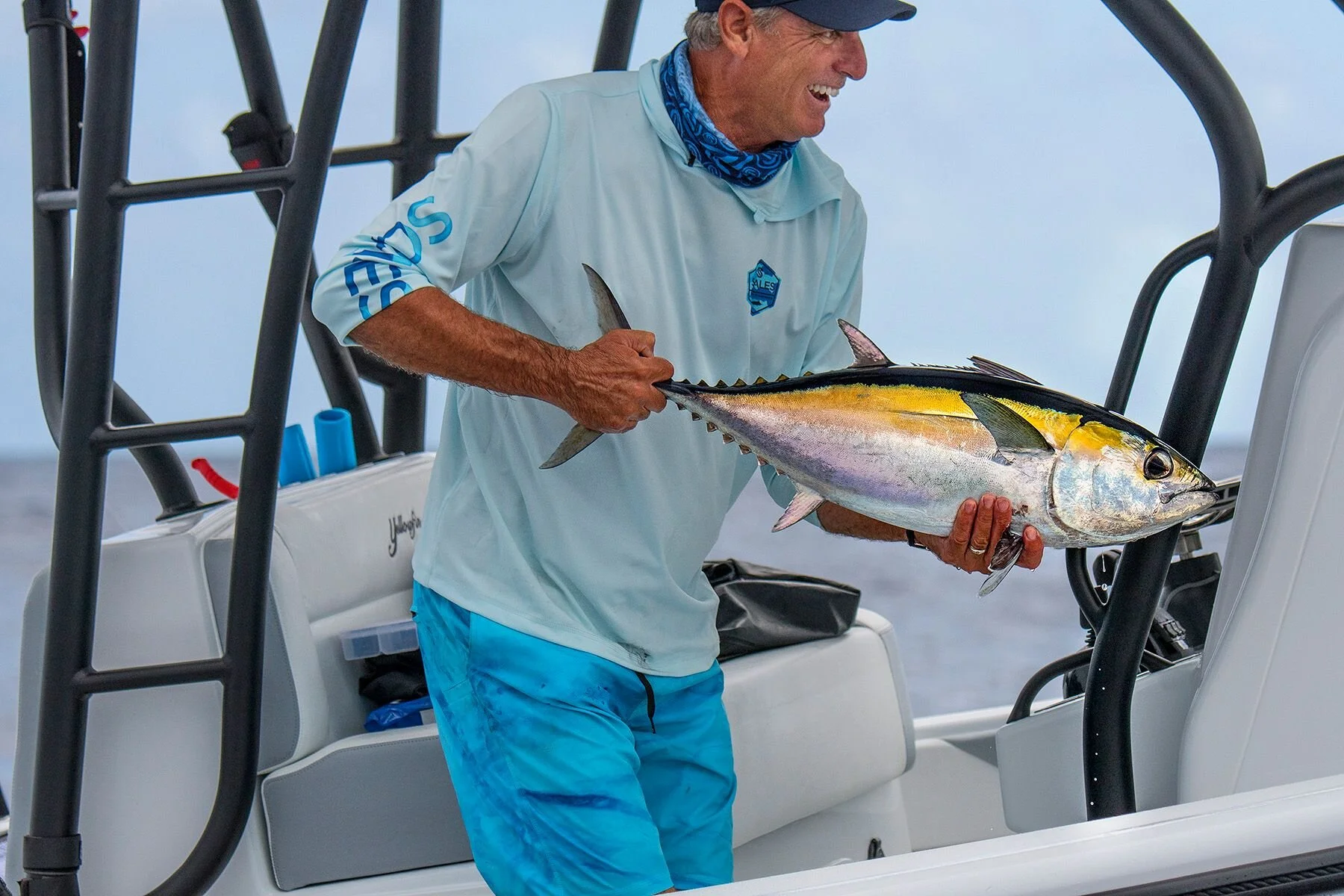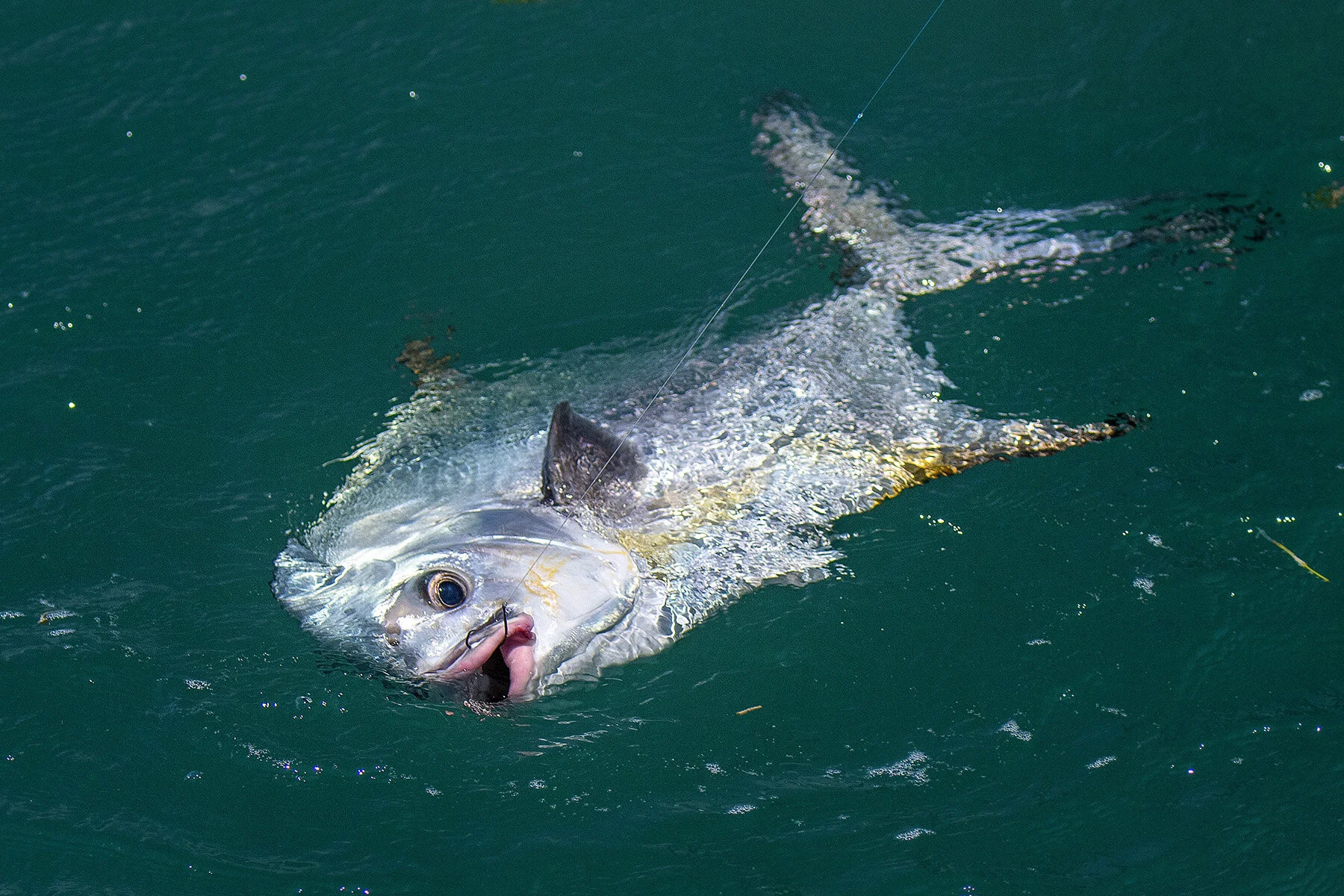How to Catch Permit in Tough Conditions pt. II
your legacy
Build your Custom yellowfin boat today
written by Evan Anderson
On the last episode of Into the Blue, Captains Scott Walker and Steve Rodger took off into the green (as Walker put it) of the Gulf of Mexico, just north of Big Pine Key. While their aim was to catch permit, they came across cobia, African pompano, and a BIG goliath grouper. This episode picks up where the last one left off, following the duo as they zero in on their target species: permit. It’s a challenging, yet rewarding day for both captains as they utilize the technology at their disposal to work around some of the less-than-favorable conditions and bring in a good permit catch.
WORKING THE CONDITIONS
The pair of anglers has had a great day so far with their grouper and cobia catch, but now it’s time to get after what they came here for: the permit. Rodger speeds his Yellowfin boat over to a wreck that he believes will hold what they’re looking for. But as clouds roll in, the conditions are about to swing away from their favor. As mentioned in Part 1, sight-fishing is the best way to catch permit. And the clouds will make that much more difficult for the Into the Blue crew.
As the Yellowfin approaches the wreck, it becomes clear that, in addition to the clouds, the water visibility is not going to help either. “When Steve pulled up to his first wreck,” says Scott Walker, “we could see that the water wasn’t ideal (ideal being you could see 10-20 feet). Even though it’s green, it’s super clear in the Gulf most of the time. And if you don’t see the permit actually finning on the surface, you can see the school moving through flashes in the water.” With murky water and a solid ceiling of clouds, they’ve got to figure out a workaround if they hope to catch some permit. Thankfully, Steve Rodger has an idea.
“Even though it’s green, it’s super clear in the Gulf most of the time. And if you don’t see the permit actually finning on the surface, you can see the school moving through flashes in the water.””
“Steve set the boat up to do drifts over common ground where they’re known to be set,” describes Walker, “We’re marking them on the Simrad bottom machine every drift and whether we got a bite or not was a matter of getting our bait into the zone.” Rodger frequently preaches his love for the Simrad’s tracking system, with dual units installed in his Yellowfin 36 Offshore, saying that “The amazing thing with technology now...is the tracks are there and they’re dead accurate. Basically, you’ll have your track and if you just go set up again on those fish in the exact same place you caught that bite a lot of times that’s where those fish are holding up.”
@ SE Multimedia 2020
GETTING THE BAIT TO THE FISH
Now that the fish are marked, it’s simply a matter of getting the bait down to them. They’re using live crab as bait, which has more weight to it than most live baits, but it will take a little finessing of their setup to get that crab into just the right spot. “We were marking [the fish] mostly at mid-level (that’s about 30 feet),” says Walker, “so we started out with a ⅜ oz jig and actually bumped it up to a ½ oz. jig. And then, all of a sudden, we were getting a bite every drift.”
Rodger adds, “Most of the time when we mark those permit...they’re not hanging around the bottom. They’ll be up above the structure, sometimes outside around the structure. When the conditions are perfect and everything’s right, it’s real calm, those fish will rise up to the top...they stick their heads out of the water, they’re flashing. We didn’t have those conditions, it’s not always that picture perfect day, so we just make do with what we’ve got. We took a weighted jig head, and with the machine we were able to mark the fish, and we would just deploy the crabs, freelining it back trying to get it to act natural. And if you were lucky enough to make that connection, where the drift and everything’s right and they didn’t get by you too quick, you hooked up immediately.”
Putting the right crab on the end of your line is another important factor in permit fishing. Walker and Rodger describe the “perfect sized crab” to be about 2-3 inches. According to Rodger, at that size “It’s got weight to it so you can make a long cast, it’s got power so it can swim.” And once you send your crab out there, Rodger’s advice for these conditions and this setup is “Don’t be scared to bring it in, toss it again, and keep an eye on the machine. A lot of times they’ll chase it down and eat it, too. All they are is a fancy jack.”
DETECTING A BITE
According to Rodger, detecting a permit bite takes some getting used to. When a permit eats a crab, it sucks it in and crushes it. “It’s a hard bite to detect because that crab is so hard that, when [the permit] crushes it, everything falls apart and you’re not connected anymore,” says Rodger, “So you really gotta be in tune with your line. You either want to be bringing in your slack real slow or feeling it as it goes out. If you think you feel a bump, you start cranking.”
After an excellent day of fishing, Rodger’s Yellowfin rockets back to the Oceans Edge Resort in Key West, FL. Reflecting on the day, Walker remarks, “It’s just a matter of looking at the conditions and dealing with it... It was just having the right guys and the right plan and all of a sudden our day came together really quickly.” Rodger, smiling, adds, “We had a really great bite going on, we caught a lot of fish, and it turned out to be a great day.”
Check out the full episode below to see these techniques in action plus a bonus tip from Scott Walker on preparing mutton throat for tacos on S12:E2 of Into the Blue. If you want more Into the Blue content, follow @intthebluetv, @captscottwalker, and @steven.rodger as well as @waypointtv on Instagram.













